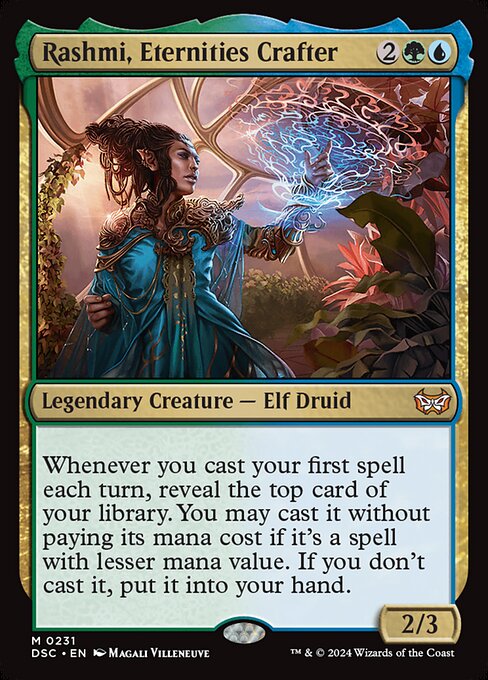
Image courtesy of Scryfall.com
Predictive data as your co-pilot for Rashmi, Eternities Crafter deck design
Deckbuilding in the age of data isn’t just about piling big spells into a big world; it’s about reading the probabilities that live under the hood of every pull, every reveal, and every decision you make on the battlefield. Rashmi, Eternities Crafter—Green-Blue, cost 4 mana with a distinctive two-color identity—asks you to mix tempo with foresight. This legendary Elf Druid from the Duskmourn: House of Horror Commander set, illustrated by Magali Villeneuve, embodies a clockwork engine: each time you cast your first spell, you reveal the top card and may cast it for free if its mana value is lower than the spell that triggered the reveal. If you don’t cast it, it heads to your hand. It’s a crisp invitation to optimize not just what you draw, but when you draw it. 🧙♂️💎
Smart predictive data tools treat Rashmi as a lens for three intertwined questions: What’s the likelihood I’ll hit a cheaper spell on top? How often will I actually be able to cast that free spell, given the current hand and mana curve? And which top-deck outcomes create the smoothest turn sequences without tipping the balance toward clunky combos? When you combine Rashmi’s ability with data-driven insights, you turn a charming comfort deck into a precise instrument for tempo, value, and surprise. The result feels almost like magic—because it is—just guided by numbers, not gut instinct. 🔥🎲
The muscle behind the method: turning reveal-and-cast into a data-informed play
Let’s translate Rashmi’s text into something a deckbuilder can optimize with predictive data. On your first spell cast each turn, you reveal the top card. If that card is a spell with lesser mana value, you may cast it for free. If not, it goes to your hand. That means two levers matter most: the distribution of mana values in your deck, and the frequency with which you cast your first spell. A data-driven approach asks: what is the probability that the top card is a desirable, low-MV spell, given different mulligan decisions, peak-CMC breakdowns, and interaction-heavy picks? It also asks: how does the presence of cantrips, tutors, and ramp affect the odds that Rashmi triggers a sequence that ends with a back-to-back free cast? And crucially, how do you mitigate the risk that you reveal something you can’t cast immediately or don’t want to cast at all? ⚔️
To make this tangible, builders leverage predictive models that simulate thousands of games or turns, then summarize outcomes like “X% of first-spell turns produce a free-cast window for a useful spell” or “Y% of reveals hit a stable top-deck that accelerates into card advantage.” The beauty of Rashmi’s design is that it rewards high-precision sequencing: choose your first spell with intent, because the top card’s MV either unlocks a free play or invites you to pivot into hand-discounted options. When you pair this with data that tracks the distribution of MV across the deck, you can tune your library, your tutor targets, and your interaction suite to maximize those sweet, free casts. 🧩
Data-driven strategies you can actually deploy
Here are the practical through-lines data helps surface for Rashmi builds:
- MV-aware sequencing: Prioritize early spells whose MV makes it likely the next top card is cheap enough to cast for free. Predictive dashboards help you map which first-spell costs lead to the most reliable free cast windows over a run of turns.
- Top-deck shaping: Use predictive scrying and deck-structure data to bias the library toward lower-MV options in the top region, increasing the odds of profitable reveals when Rashmi untangles the turn. This is where library curation becomes a strategic art, not just a fisherman’s luck.
- Tempo balance: Data flags when Rashmi-led turns slide from “wind-your-way to value” to “overextend into fatigue.” The right data prompts a cadence that keeps pressure on opponents while preserving your own mana battery for free casts.
- Risk-aware drawing: In commander’s long game, predictive signals help decide when to lean into draws versus proactive plays, ensuring Rashmi’s engine stays online without bloating your hand with underpowered top cards.
- Artifact and interaction economy: For decks that lean on counterspells or disruption, predictive data reveals how often you’ll still be able to exploit a cheap top spell while protecting Rashmi from removal and denial spells.
Additionally, the ship of fancy predictive data sails best with a stable, tasteful core. Rashmi’s two-color identity invites a measured mix of ramp, card draw, and interaction—elements that, when optimized with data, deliver a smoother glide path to powerful free-casts without tipping into reckless over-ambition. And let’s not forget the community and culture around this card: the set Duskmourn: House of Horror Commander—where Commander fans celebrate iconic two-color engines and the joy of pulling a satisfying top-deck moment. The card’s mythic status and the Magali Villeneuve illustration remind us that even in data-driven design, artistry and flavor still matter. 🎨
As you lean into predictive tooling, Rashmi’s synergy also serves as a reminder of the human element: a deck that learns from data is still a deck that must be held in your hand, felt on the battlefield, and adjusted with playtest discipline. The math supports your intuition, it doesn’t replace it. That balance—between rigorous projection and the storytelling thrill of a well-timed free cast—keeps this two-color engine both elegant and exciting. 🧙♀️
Rashmi’s artwork, the density of the Duskmourn set, and the hybrid mana cost of {2}{G}{U} all come together to offer players a design playground where predictive data and deck feel can coexist. It’s a reminder that modern deckbuilding isn’t just about raw power; it’s about shaping probability into cinematic moments that feel like fate, not fatigue. And in those moments, you’ll hear the soft hum of the metagame’s heart beating in sync with your own. 💎
Non-Slip Gaming Mouse Pad Anti-Fray Edges 9-5x8inMore from our network
- https://blog.digital-vault.xyz/blog/post/key-metrics-every-digital-product-owner-should-track/
- https://crypto-acolytes.xyz/blog/post/splatoon-3-vs-splatoon-2-which-wins/
- https://blog.digital-vault.xyz/blog/post/legends-linked-to-ob-nixilis-the-adversarys-ability/
- https://blog.digital-vault.xyz/blog/post/rustic-farmhouse-digital-paper-design-for-crafters/
- https://crypto-acolytes.xyz/blog/post/minecraft-rare-blocks-guide-find-them-all/